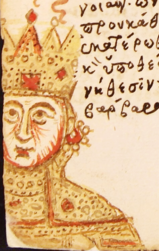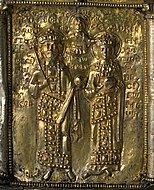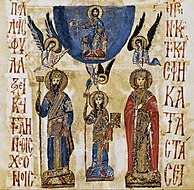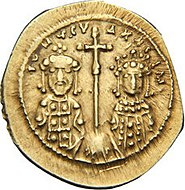| Eudokia Makrembolitissa | |
|---|---|
| Augusta Empress and Autocratess of the Romans | |
 Contemporary miniature of empress Eudokia Contemporary miniature of empress Eudokia | |
| Byzantine empress regnant or regent | |
| Rule | 23 May – 31 December 1067 (also regent for her co-emperor Michael VII) |
| Predecessor | Constantine X |
| Successor | Romanos IV |
| Co-emperors | Michael VII and Konstantios Doukas |
| Byzantine empress consort | |
| Tenure | 1059–1067 (as wife of Constantine X) 1068–1071 (as wife of Romanos IV) |
| Born | c. 1030 |
| Died | after 1081 |
| Spouse |
|
| Issue | by Constantine X Michael VII Doukas A son Anne Doukaina Andronikos Doukas Theodora Doukaina Konstantios Doukas Zoe Doukaina by Romanos IV Nikephoros Diogenes Leo Diogenes |
| Dynasty | Doukid |
| Religion | Orthodox |
Eudokia Makrembolitissa (Greek: Εὐδοκία Μακρεμβολίτισσα, romanized: Evdokía Makremvolítissa) was a Byzantine empress by her successive marriages to Constantine X Doukas and Romanos IV Diogenes. She acted as regent of her minor son, Michael VII in 1067, and resigned her regency by marriage to Romanos IV Diogenes. When he was deposed in 1071 she resumed the regency for her sons, but was soon forced to resign again.
Because she essentially ruled in her own right during her sole regencies and retained the title of empress, several modern scholars consider Eudokia to have been empress regnant in 1067 and some also in 1071.
Background and early life
Eudokia Makrembolitissa was the daughter of John Makrembolites and a niece of Michael I Cerularius, the patriarch of Constantinople, whose sister had married Makrembolites. John, who belonged to the aristocracy of Constantinople, allied with Cerularius in 1040 to conspire against Emperor Michael IV, but their plan was stopped soon after. The birth date of Eudokia is unknown, but scholars often place it c. 1030. Some authors give her a lifespan of 1021–1096, but this is not corroborated by other sources. Eudokia married Constantine X Doukas sometime before his accession in 1059, probably c. 1049, when Constantine was 43 years old. She was Constantine's second wife, as his first one, a daughter of Duke Constantine Dalassenos, died soon after their marriage. By 1059 they already had at least five children: the future Michael VII, an unnamed son who died young, Andronikos Doukas, Anna Doukaina and Theodora Doukaina.
Empress
Constantine X Doukas was crowned emperor on 23 November 1059, the day after Isaac I Komnenos' abdication. Eudokia was crowned augusta soon after, probably on the same year. They had a fourth son around this time, Konstantios Doukas, who was crowned before his brother Michael, and an other daughter, Zoe. When Constantine fell ill in October 1066, he appointed caesar John Doukas and patriarch John VIII Xiphilinos as co-regents. Eudokia was meant to only take care of Michael and Konstantios, but Constantine knew that she had larger ambitions. Constantine died the next year, on 23 May 1067.
In 1825, Charles Abraham Elton counted Eudocia among the monarchs of the Byzantine Empire in his History of the Roman Emperors. Some historians regard Eudokia as an empress regnant who actually ruled in her own right, rather than just a regent. According to the contemporary Michael Psellos, Eudokia "succeeded as supreme ruler, she did not hand over the government to others... she assumed control of the whole administration in person. Michael VII was "already long past his boyhood" by this time, but nevertheless "left the whole administration to his mother". Some authors argue that he had some type of mental disability.
Her status as a ruler is reflected in her coinage and public iconography. For example, she sometimes appeared on silver and copper coins without her sons, which was very unusual. One inscription on a silver reliquary calls her "Great Empress of the Romans" (megalē basilis tōn Romaiōn), suggesting that she had a higher status than her sons (who were only basileus). Some inscriptions of 1067 ascribe the masculine title Emperor to her. On a tetarteron probably of late 1067, the inscription reads 'Eudokia and Michael, emperors', and on a seal, probably dated between May and December 1067, the inscription reads 'Eudokia, Michael and Constantios, emperors of the Romaioi'.
Eudokia had sworn on Constantine's deathbed not to remarry, and she even made the oath in the presence of patriarch John VIII Xiphilinos. However, she knew that her position of power could be compromised if she continued to wield power alone. She then chose Romanos IV Diogenes, a general who had great popularity with the army. This decision was quite controversial, as Romanos had been accused of conspiring with the Hungarians shortly before Constantine X's death. Eudokia hoped that his skills and leadership would stop the advance of the Seljuk Turks in the East. On 25 December, Eudokia rewarded Romanos with the titles magistros and stratelates in preparation for his coronation. However, they still needed the approval of the patriarch of Constantinople. According to some sources, Eudokia tricked John VIII into believing that she would marry one of his brothers. John VIII accepted the offer and canceled the oath. The marriage and imperial coronation took place on 1 January 1068, to the surprise of the patriarch and other officials.

With her new husband's assistance, Eudokia was able to dispel the impending danger. She had two sons with Romanos IV, Nikephoros and Leo. Another of Eudokia and Constantine's sons, Andronikos Doukas, was also made co-emperor by Romanos IV, although he had been excluded from power by his own father, mother, and brothers. He was probably crowned too in 1068, although he is ignored by contemporary chronicles. Contemporary coinage seems to depict Romanos as inferior to Michael and his brothers, and thus inferior to the empress. He is sometimes not even called "emperor", as some tetarteron only call him despotes and reserve the title basileus for Eudokia. According to Michael Psellos, she explicitly referred to him as "a subject, not a ruler." Romanos IV, however, soon started to act independently of her, even starting to resent her. Discontent was also shared by a faction of the Senate and army, with John Doukas at the head.
On 26 August 1071, Romanos IV faced Alp Arslan, sultan of the Seljuk Empire, at the decisive Battle of Manzikert. The Byzantine army was destroyed and the emperor himself was captured, partly because of the treachery of general Andronikos, John Doukas's son. The news reached Constantinople a few days later, causing much shock in the populace. On 1 October the Senate declared Romanos IV deposed and proclaimed Eudokia and Michael VII as joint rulers. Some sources state that Eudokia was already planning on deposing her husband, but this is very unlikely. The new regime only lasted one month, when Eudokia's opposition became strong enough to depose her, especially after news of Romanos release arrived at the capital. Michael VII was then proclaimed sole autokrator by John Doukas, who forced Eudokia to retire to a monastery as a nun.
Later life
Eudokia continued to be influential even after her exile in 1071. Soon after her deposition, she allied with Anna Dalassene, a sister-in-law of Isaac I Komnenos who had also been exiled, to restore Romanos IV and depose John Doukas. However, Doukas soon fell from grace as a result of the schemes of eunuch Nikephoritzes, who was close to the Komnenos family. Eudokia later performed a memorable funeral and burial for Romanos IV, who died on 4 August 1072.
After Michael VII was deposed in 1078 by Nikephoros III Botaneiates, Eudokia was recalled to Constantinople by the new emperor, who offered to marry her. This plan did not come to pass, mainly due to the opposition of John Doukas, who returned to power after Nikephoritzes's exile. However, Nikephoros still sent her many rewards and gifts of gratitude. Her date of death is unknown, but it was sometime after the accession of Alexios I Komnenos in 1081. Her last known action is the adoption of one of the cousins of Patriarch Michael I Cerularius.
Attributed to Eudokia is a dictionary of history and mythology, called Ἰωνιά (i.e., Collection or Bed of Violets). It is prefaced by an address to her husband, Romanos Diogenes, and the work is described as "a collection of genealogies of gods, heroes, and heroines, of their metamorphoses, and of the fables and stories respecting them found in the ancients; containing also notices of various philosophers". However, the book is now thought to be a modern (16th-century) compilation, falsely attributed to Eudokia, and compiled by the counterfeiter Constantine Paleocappa c. 1540. The sources from which the work was compiled include Diogenes Laërtius and the Suda.
-
 Constantine X and Eudokia in a reliquary of Demetrius of Thessaloniki, by John Autoreianos.
Constantine X and Eudokia in a reliquary of Demetrius of Thessaloniki, by John Autoreianos.
-
 Miniature of Constantine X and Eudokia alongside their son and co-emperor Michael VII Doukas.
Miniature of Constantine X and Eudokia alongside their son and co-emperor Michael VII Doukas.
-
 Gold tetarteron of Romanos IV Diogenes and Eudokia.
Gold tetarteron of Romanos IV Diogenes and Eudokia.
Issue
By her first husband, Eudokia had seven children, four sons and three daughters:
- Michael VII Doukas, co-emperor from 1060 and senior emperor after 1071.
- A son who died in infancy.
- Anne Doukaina, nun.
- Andronikos Doukas, co-emperor from 1068 to 1078.
- Theodora Doukaina, who married Domenico Selvo, Doge of Venice.
- Konstantios Doukas, co-emperor from 1060 to 1078, died in battle with the Normans in 1081.
- Zoe Doukaina, who married Adrianos Komnenos, a brother of Emperor Alexios I Komnenos. They had a son, Alexios, and two daughters, maybe named Anne and Alexia.
By her second husband, she had two sons, most likely twins:
- Nikephoros Diogenes, blinded by order of Alexios I Comnenus on charges of treason.
- Leo Diogenes, died in battle.
Notes
- Previously thought to be Irene Doukaina. The red hair seems to be a later addition.
- One chronicle states that their joint rule began on 1 October and that it lasted "one month". Schreiner dates Eudokia's fall to 1 November.
- The inscription reads: "Constantine Doukas in Christ the Lord, pious Basileus and Autokrator of the Romans / Eudokia in Christ the Lord, great Basilissa of the Romans."
References
- Sághy & Robert 2019, p. 162.
- ^ Spatharakis 1976, pp. 27–34.
- ^ ODB, p. 739.
- ^ PBW, Eudokia 1.
- ^ Garland 2002, p. 168.
- ODB, p. 1272, 1361.
- Treadgold 1997, p. 608.
- ^ Chisholm 1911.
- ODB, p. 504.
- Garland 2002, pp. 168–169.
- ^ Grierson 1973, p. 779.
- ^ Grierson 1973, p. 764.
- Garland 2002, p. 169.
- Elton, Charles Abraham (1825). A History of the Roman Emperors: From the Accession of Augustus to the Fall of the Last Constantine. Baldwin, Cradock and Joy. p. 304.
- McLachlan 2004, p. 236.
- Haldon 2005, p. 176.
- Psellos, Eudocia 1.
- Psellos, Eudocia 2.
- ODB, p. 1366.
- ^ Garland 2002, pp. 170−172.
- Garland 2002, p. 172.
- ^ Finlay 1877, p. 24.
- ^ Garland 2002, p. 173.
- Hill 2014, p. 63.
- ^ Finlay 1877, p. 25.
- ^ Garland 2002, pp. 173−174.
- ^ Hill 2014, p. 64.
- Psellos, Eudocia 8.
- Psellos, Romanos 10.
- Finlay 1877, pp. 24–25.
- ^ Grierson 1973, p. 780.
- Schreiner 1975, p. 170.
- ^ Garland 2002, p. 176.
- Finlay 1877, pp. 31–33.
- Psellos, Romanos 23.
- ^ Schreiner 1975, p. 161.
- ^ Vratimos 2003.
- ^ Garland 2002, p. 177.
- ^ Hill 2014, p. 65.
- ^ Garland 2002, p. 178.
- Smith 1870.
- ^ Dorandi 2013.
- ^ Evans & Wixom 1997, pp. 77–78.
- Norwich, John Julius (1993). Byzantium. 2: The apogee. London: Penguin Books. p. 301. ISBN 978-0-14-011448-5.
- Bartusis, Mark C. (2012). Land and privilege in Byzantium: the institution of pronoia. Cambridge New York: Cambridge University Press. p. 147. ISBN 978-1-107-00962-2.
Bibliography
Primary sources
- Psellos, Michael. Cronographia. Vol. 7.
Secondary sources
- Evans, Helen C.; Wixom, William D. (1997). The glory of Byzantium: art and culture of the Middle Byzantine era. New York: Metropolitan Museum of Art. ISBN 9780810965072.
- Finlay, George (1877) . "Regency of Eudocia (1067)". History of the Byzantine and Greek Empires from 1057–1453. William Blackwood & Sonspages. pp. 24–36.
- Garland, Lynda (2002). "Eudokia Makrembolitissa". Byzantine Empresses: Woman and Power in Byzantium. Routledge. pp. 168–179. ISBN 9781134756384.
- Grierson, Philip (1973). "Eudocia Macrembolitissa". Catalogue of the Byzantine Coins. Vol. 3. Washington D.C.: Dumbarton Oaks Papers. pp. 779–784. ISBN 0-88402-012-6.
- Jeffreys, Michael, ed. (2016). "Eudokia Makrembolitissa". Prosopography of the Byzantine World. King's College London. ISBN 978-1-908951-20-5.
- Hill, Barbara (2014). Imperial Women in Byzantium 1025-1204 : Power, Patronage and Ideology. Hoboken: Taylor and Francis. ISBN 978-1-317-88466-8. OCLC 881417376.
- Kazhdan, Alexander, ed. (1991). "Eudokia Makrembolitissa". The Oxford Dictionary of Byzantium. Oxford and New York: Oxford University Press. ISBN 0-19-504652-8.
- Haldon, John (2005). The Palgrave Atlas of Byzantine History. New York: Palgrave Macmillan. ISBN 978-0230243644.
- Sághy, Marianne; Robert, Ousterhout (2019), Piroska and the Pantokrator, Central European University Press, ISBN 9789633862971
- Spatharakis, Ioannis (1976), The Portrait in Byzantine Illuminated Manuscripts, Brill, ISBN 9789633862971
- Schreiner, Peter (1975). Die byzantinischen Kleinchronike [Byzantine small chronicles]. Corpus Fontium Historiae Byzantinae. Vienna: ÖAW. ISBN 978-3-7001-0206-9.
- Treadgold, Warren (1997). A History of the Byzantine State and Society. Stanford, California: Stanford University Press. ISBN 0-8047-2630-2.
- Vratimos, Antonios (2003). "Eudokia Makrembolitissa: was she implicated in the removal of her husband, Romanos IV Diogenes, from power?". Revue des études byzantines. 71: 277–284. doi:10.3406/rebyz.2013.4998.
- McLachlan, Sean (2004). Byzantium: An Illustrated History. Hippocrene Books. ISBN 0-7818-1033-7.
- Dorandi, Tiziano (2013). "Introduction". Diogenes Laertius: Lives of Eminent Philosophers. Cambridge University Press. pp. 7–9. ISBN 978-0521886819.
 This article incorporates text from a publication now in the public domain: Chisholm, Hugh, ed. (1911). "Eudocia Macrembolitissa". Encyclopædia Britannica. Vol. 9 (11th ed.). Cambridge University Press.
This article incorporates text from a publication now in the public domain: Chisholm, Hugh, ed. (1911). "Eudocia Macrembolitissa". Encyclopædia Britannica. Vol. 9 (11th ed.). Cambridge University Press. Smith, William, ed. (1870), "Eudocia Augusta Macrembolis", Dictionary of Greek and Roman Biography and Mythology, vol. 2, p. 80
Smith, William, ed. (1870), "Eudocia Augusta Macrembolis", Dictionary of Greek and Roman Biography and Mythology, vol. 2, p. 80
| Eudokia Makrembolitissa Makrembolites | ||
| Regnal titles | ||
|---|---|---|
| Preceded byConstantine X | Byzantine empress regnant 23 May – 31 December 1067 |
Succeeded byRomanos IV |
| Royal titles | ||
| Preceded byCatherine of Bulgaria | Byzantine empress consort 23 November 1059 – 23 May 1067 and 1 January 1068 – 1 October 1071 |
Succeeded byMaria of Alania |
| Roman and Byzantine empresses | |||||
|---|---|---|---|---|---|
| Principate 27 BC – AD 235 |
| ||||
| Crisis 235–285 | |||||
| Dominate 284–610 |
| ||||
| Eastern/ Byzantine Empire 610–1453 |
| ||||
| See also | |||||
| Italics indicates a consort to a junior co-emperor, underlining indicates a consort to an emperor variously regarded as either legitimate or a usurper, and bold incidates an empress regnant. | |||||
- 1030s births
- Byzantine empresses regnant
- Remarried empresses consort
- 11th-century regents
- 11th-century women writers
- Doukid dynasty
- 11th-century Byzantine empresses
- Byzantine women writers
- Makrembolites family
- Augustae
- 11th-century Byzantine writers
- 11th-century Byzantine nuns
- Byzantine regents
- 11th-century women regents
- Mothers of Byzantine emperors